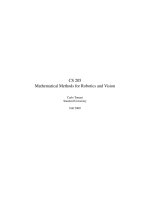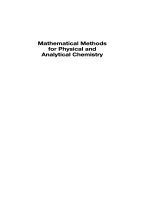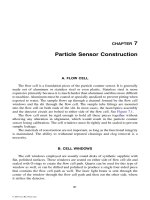CS 205 Mathematical Methods for Robotics and Vision - Chapter 7 potx
Bạn đang xem bản rút gọn của tài liệu. Xem và tải ngay bản đầy đủ của tài liệu tại đây (144.98 KB, 17 trang )
Chapter 7
Stochastic State Estimation
Perhaps the most important part of studying a problem in robotics or vision, as well as in most other sciences, is to
determine a good model for the phenomena and events that are involved. For instance, studying manipulationrequires
defining models for howa robot arm can move and forhow it interacts with the world. Analyzingimage motion implies
defining models for how points move in space and how this motion projects onto the image. When motion is involved,
as is very often the case, models take on frequently the form of dynamic systems. A dynamic system is a mathematical
description of a quantity that evolves over time. The theory of dynamic systems is both rich and fascinating. Although
in this chapter we will barely scratch its surface, we will consider one of its most popularand useful aspects, the theory
of state estimation, in the particular form of Kalman filtering. To this purpose, an informal definition of a dynamic
system is given in the next section. The definition is then illustrated by setting up the dynamic system equations for a
simple but realistic application, that of modeling the trajectory of an enemy mortar shell. In sections 7.3 through 7.5,
we will develop the theory of the Kalman filter, and in section 7.6 we will see that the shell can be shot down before
it hits us. As discussed in section 7.7, Kalman filtering has intimate connections with the theory of algebraic linear
systems we have developed in chapters 2 and 3.
7.1 Dynamic Systems
In its most general meaning, the term system refers to some physical entity on which some action is performed by
means of an input . The system reacts to this input and produces an output (see figure 7.1).
A dynamic system is a system whose phenomena occur over time. One often says that a system evolves over time.
Simple examples of a dynamic system are the following:
An electric circuit, whose input is the current in a given branch and whose output is a voltage across a pair of
nodes.
A chemical reactor, whose inputs are the external temperature, the temperature of the gas being supplied, and
the supply rate of the gas. The output can be the temperature of the reaction product.
A mass suspended from a spring. The input is the force applied to the mass and the output is the position of the
mass.
input outputsystem
Suy
Figure 7.1: A general system.
83
84 CHAPTER 7. STOCHASTIC STATE ESTIMATION
In all these examples, what is input and what is output is a choice that depends on the application. Also, all the
quantities in the examples vary continuously with time. In other cases, as for instance for switching networks and
computers, it is more natural to consider time as a discrete variable. If time varies continuously, the system is said to
be continuous; if time varies discretely, the system is said to be discrete.
7.1.1 State
Given a dynamic system, continuous or discrete, the modeling problem is to somehow correlate inputs (causes) with
outputs (effects). The examples above suggest that the output at time cannot be determined in general by the value
assumed by the input quantity at the same point in time. Rather, the output is the result of the entire history of the
system. An effort of abstraction is therefore required, which leads to postulatinga new quantity, called the state, which
summarizes information about the past and the present of the system. Specifically, the value x
taken by the state at
time must be sufficient to determine the output at the same point in time. Also, knowledge of both x and u ,
that is, of the state at time and the input over the interval , must allow computing the state (and hence
the output) at time . For the mass attached to a spring, for instance, the state could be the position and velocity of the
mass. In fact, the laws of classical mechanics allow computing the new position and velocity of the mass at time
given its position and velocity at time and the forces applied over the interval . Furthermore, in this example,
the output y of the system happens to coincide with one of the two state variables, and is therefore always deducible
from the latter.
Thus, in a dynamic system the input affects the state, and the output is a function of the state. For a discrete
system, the way that the input changes the state at time instant number into the new state at time instant can
be represented by a simple equation:
x x u
where is some function that represents the change, and u is the input at time . Similarly, the relation between state
and output can be expressed by another function:
y x
A discrete dynamic system is completely described by these two equations and an initial state x . In general, all
quantities are vectors.
For continuous systems, time does not come in quanta, so one cannot compute x as a function of x , u , and
, but rather compute x as a functional of x and the entire input u over the interval :
x x u
where u represents the entire function u, not just one of its values. A description of the system in terms of
functions, rather than functionals, can be given in the case of a regular system, for which the functional is continuous,
differentiable, and with continuous first derivative. In that case, one can show that there exists a function such that
the state x of the system satisfies the differential equation
x x u
where the dot denotes differentiation with respect to time. The relation from state to output, on the other hand, is
essentially the same as for the discrete case:
y x
Specifying the initial state x completes the definition of a continuous dynamic system.
7.1.2 Uncertainty
The systems defined in the previous section are called deterministic, since the evolution is exactly determined once
the initial state x at time is known. Determinism implies that both the evolution function and the output function
are known exactly. This is, however, an unrealistic state of affairs. In practice, the laws that govern a given physical
7.2. AN EXAMPLE: THE MORTAR SHELL 85
system are known up to some uncertainty. In fact, the equations themselves are simple abstractions of a complex
reality. The coefficients that appear in the equations are known only approximately, and can change over time as a
result of temperature changes, component wear, and so forth. A more realistic model then allows for some inherent,
unresolvable uncertainty in both
and . This uncertainty can be represented as noise that perturbs the equations we
have presented so far. A discrete system then takes on the following form:
x x u
y x
and for a continuous system
x x u
y x
Without loss of generality, the noise distributions can be assumed to have zero mean, for otherwise the mean can be
incorporated into the deterministic part, that is, in either or . The mean may not be known, but this is a different
story: in general the parameters that enter into the definitions of and must be estimated by some method, and the
mean perturbations are no different.
A common assumption, which is sometimes valid and always simplifies the mathematics, is that and are
zero-mean Gaussian random variables with known covariance matrices and , respectively.
7.1.3 Linearity
The mathematics becomes particularly simple when both the evolution function and the output function are linear.
Then, the system equations become
x x u
y x
for the discrete case, and
x x u
y x
for the continuous one. It is useful to specify the sizes of the matrices involved. We assume that the input u is a vector
in , the state x is in , and the output y is in . Then, the state propagationmatrix is , the input matrix
is , and the output matrix is . The covariance matrix of the system noise is , and the
covariance matrix of the output noise is .
7.2 An Example: the Mortar Shell
In this section, the example of the mortar shell will be discussed in order to see some of the technical issues involved
in setting up the equations of a dynamic system. In particular, we consider discretization issues because the physical
system is itself continuous, but we choose to model it as a discrete system for easier implementation on a computer.
In sections 7.3 through 7.5, we consider the state estimation problem: given observations of the output y over an
interval of time, we want to determine the state x of the system. This is a very important task. For instance, in the case
of the mortar shell, the state is the (initially unknown) position and velocity of the shell, while the output is a set of
observations made by a tracking system. Estimating the state then leads to enough knowledge about the shell to allow
driving an antiaircraft gun to shoot the shell down in mid-flight.
You spotted an enemy mortar installation about thirty kilometers away, on a hill that looks about 0.5 kilometers
higher than your own position. You want to track incoming projectiles with a Kalman filter so you can aim your guns
86 CHAPTER 7. STOCHASTIC STATE ESTIMATION
accurately. You do not know the initialvelocity of the projectiles, so you just guess some values: 0.6 kilometers/second
for the horizontalcomponent, 0.1 kilometers/second for the vertical component. Thus, your estimate of the initialstate
of the projectile is
x
where is the horizontal coordinate, isthe vertical, you are at , and dots denote derivatives with respect to time.
From your high-school physics, you remember that the laws of motion for a ballistic trajectory are the following:
(7.1)
(7.2)
where is the gravitational acceleration, equal to kilometers per second squared. Since you do not trust
your physics much, and you have little time to get ready, you decide to ignore air drag. Because of this, you introduce
a state update covariance matrix , where is the identity matrix.
All you have to track the shells is a camera pointed at the mortar that will rotate so as to keep the projectile at the
center of the image, where you see a blob that increases in size as the projectile gets closer. Thus, the aiming angle of
the camera gives you elevation information about the projectile’s position, and the size of the blob tells you something
about the distance, given that you know the actual size of the projectiles used and all the camera parameters. The
projectile’s elevation is
(7.3)
when the projectile is at . Similarly, the size of the blob in pixels is
(7.4)
You do not have very precise estimates of the noise that corrupts and , so you guess measurement covariances
, which you put along the diagonal of a diagonal measurement covariance matrix .
7.2.1 The Dynamic System Equation
Equations (7.1) and (7.2) are continuous. Since you are taking measurements every seconds, you want to
discretize these equations. For the component, equation (7.2) yields
since .
Consequently, if is time instant and is time instant , you have
(7.5)
The reasoning for the horizontal component is the same, except that there is no acceleration:
(7.6)
7.2. AN EXAMPLE: THE MORTAR SHELL 87
Equations (7.5) and (7.6) can be rewritten as a single system update equation
x x
where
x
is the state, the matrix depends on , the control scalar is equal to , and the control matrix
depends on . The two matrices and are as follows:
7.2.2 The Measurement Equation
The two nonlinear equations (7.3) and (7.4) express the available measurements as a function of the true values of the
projectile coordinates and . We want to replace these equations with linear approximations. To this end, we develop
both equations as Taylor series around the current estimate and truncate them after the linear term. From the elevation
equation (7.3), we have
so that after simplifying we can redefine the measurement to be the discrepancy from the estimated value:
(7.7)
We can proceed similarly for equation (7.4):
and after simplifying:
(7.8)
The two measurements and just defined can be collected into a single measurement vector
y
and the two approximate measurement equations (7.7) and (7.8) can be written in the matrix form
y x (7.9)
where the measurement matrix depends on the current state estimate x :
88 CHAPTER 7. STOCHASTIC STATE ESTIMATION
As the shell approaches us, we frantically start studying state estimation, and in particular Kalman filtering, in the
hope to build a system that lets us shoot down the shell before it hits us. The next few sections will be read under this
impending threat.
Knowing the model for the mortar shell amounts to knowing the laws by which the object moves and those that
relate the position of the projectile to our observations. So what else is there left to do? From the observations, we
would like to know where the mortar shell is right now, and perhaps predict where it will be in a few seconds, so we
can direct an antiaircraft gun to shoot down the target. In other words, we want to know x
, the state of the dynamic
system. Clearly, knowing x instead is equivalent, at least when the dynamics of the system are known exactly (the
system noise is zero). In fact, from x we can simulate the system up until time , thereby determining x as well.
Most importantly, we do not want to have all the observations before we shoot: we would be dead by then. A scheme
that refines an initial estimation of the state as new observations are acquired is called a recursive state estimation
system. The Kalman filter is one of the most versatile schemes for recursive state estimations. The original paper
by Kalman (R. E. Kalman, “A new approach to linear filtering and prediction problems,” Transactions of the ASME
Journal Basic Engineering, 82:34–45, 1960) is still one of the most readable treatments of this subject from the point
of view of stochastic estimation.
Even without noise, a single observation y may not be sufficient to determine the state x (in the example, one
observation happens to be sufficient). This is a very interesting aspect of state estimation. It is really the ensemble
of all observations that let one estimate the state, and yet observations are processed one at a time, as they become
available. A classical example of thissituationin computer visionis the reconstructionofthree-dimensionalshape from
a sequence of images. A single image is two-dimensional, so by itself it conveys no three-dimensional information.
Kalman filters exist that recover shape informationfrom a sequence of images. See forinstance L. Matthies, T. Kanade,
and R. Szeliski, “Kalman filter-based algorithms for estimating depth from image sequences,” InternationalJournal of
Computer Vision, 3(3):209-236, September 1989; and T.J. Broida, S. Chandrashekhar, and R. Chellappa, “Recursive
3-D motion estimation from a monocular image sequence,” IEEE Transactions on Aerospace and Electronic Systems,
26(4):639–656, July 1990.
Here, we introduce the Kalman filter from the simpler point of view of least squares estimation, since we have
developed all the necessary tools in the first part of this course. The next section defines the state estimation problem
for a discrete dynamic system in more detail. Then, section 7.4 defines the essential notions of estimation theory
that are necessary to understand the quantitative aspects of Kalman filtering. Section 7.5 develops the equation of the
Kalman filter, and section 7.6 reconsiders the example of the mortar shell. Finally, section 7.7 establishes a connection
between the Kalman filter and the solution of a linear system.
7.3 State Estimation
In this section, the estimation problem is defined in some more detail. Given a discrete dynamic system
x x u (7.10)
y x (7.11)
where the system noise and the measurement noise are Gaussian variables,
as well as a (possibly completely wrong) estimate x of the initial state and an initial covariance matrix of the
estimate x , the Kalman filter computes the optimal estimate x at time given the measurements y y . The
filter also computes an estimate of the covariance of x given those measurements. In these expressions, the hat
means that the quantity is an estimate. Also, the first in the subscript refers to which variable is being estimated, the
second to which measurements are being used for the estimate. Thus, in general,x is the estimate of the value that
x assumes at time given the first measurements y y .
The term “recursive” in the systems theory literature corresponds loosely to “incremental” or “iterative” in computer science.
7.3. STATE ESTIMATION 89
k | k-1
^
y
H
k
x
k | k-1
^
x
^
k | k
k | k
P
x
^
P
k+1 | k
k+1 | k
propagatepropagate
x
^
P
k-1 | k-1
k-1 | k-1
y
k
y
k-1
y
k+1
k
update
k | k-1
P
k-1 k+1
time
Figure 7.2: The update stage of the Kalman filter changes the estimate of the current system state x to make the
prediction of the measurement closer to the actual measurement y . Propagation then accounts for the evolution of the
system state, as well as the consequent growing uncertainty.
7.3.1 Update
The covariance matrix must be computed in order to keep the Kalman filter running, in the following sense. At
time , just before the new measurement y comes in, we have an estimate x of the state vector x based on the
previous measurements y y . Now we face the problem of incorporating the new measurement y into our
estimate, that is, of transforming x into x .Ifx were exact, we could compute the new measurement y
without even looking at it, through the measurement equation (7.11). Even if x is not exact, the estimate
y x
is still our best bet. Now y becomes available, and we can consider the residue
r y y y x
If this residue is nonzero, we probably need to correct our estimate of the state x , so that the new prediction
y x
of the measurement value is closer to the old prediction
y x
we made just before the new measurement y was available.
The question however is, by how much should we correct our estimate of the state? We do not want to make y
coincide with y . That would mean that we trust the new measurement completely, but that we do not trust our state
estimate x at all, even if the latter was obtained through a large number of previous measurements. Thus, we
need some criterion for comparing the quality of the new measurement y with that of our old estimate x of the
state. The uncertainty about the former is , the covariance of the observation error. The uncertainty about the state
just before the new measurement y becomes available is . The update stage of the Kalman filter uses and
to weigh past evidence (x ) and new observations (y ). This stage is represented graphically in the middle
of figure 7.2. At the same time, also the uncertainty measure must be updated, so that it becomes available for
the next step. Because a new measurement has been read, this uncertainty becomes usually smaller: .
The idea is that as time goes by the uncertainty on the state decreases, while that about the measurements may
remain the same. Then, measurements count less and less as the estimate approaches its true value.
90 CHAPTER 7. STOCHASTIC STATE ESTIMATION
7.3.2 Propagation
Just after arrival of the measurement y , both state estimate and state covariance matrix have been updated as described
above. But between time and time both state and covariance may change. The state changes according to the
system equation (7.10), so our estimate x of x given y y should reflect this change as well. Similarly,
because of the system noise , our uncertainty about this estimate may be somewhat greater than one time epoch ago.
The system equation (7.10) essentially “dead reckons” the new state from the old, and inaccuracies in our model of
how this happens lead to greater uncertainty. This increase in uncertainty depends on the system noise covariance .
Thus, both state estimate and covariance must be propagated to the new time
to yield the new state estimate
x and the new covariance . Both these changes are shown on the right in figure 7.2.
In summary, just as the state vector x represents all the information necessary to describe the evolution of a
deterministic system, the covariance matrix contains all the necessary information about the probabilistic part of
the system, that is, about how both the system noise and the measurement noise corrupt the quality of the state
estimate x .
Hopefully, this intuitive introduction to Kalman filtering gives you an idea of what the filter does, and what
information it needs to keep working. To turn these concepts into a quantitativealgorithm we need some preliminaries
on optimal estimation, which are discussed in the next section. The Kalman filter itself is derived in section 7.5.
7.4 BLUE Estimators
In what sense does the Kalman filter use covariance information to produce better estimates of the state? As we will
se later, the Kalman filter computes the Best Linear Unbiased Estimate (BLUE) of the state. In this section, we see
what this means, starting with the definition of a linear estimation problem, and then considering the attributes “best”
and “unbiased” in turn.
7.4.1 Linear Estimation
Given a quantity y (the observation) that is a known function of another (deterministic but unknown) quantity x (the
state) plus some amount of noise,
y x n (7.12)
the estimation problem amounts to finding a function
x y
such that x is as close as possible to x. The function is called an estimator, and its value x given the observations y is
called an estimate. Inverting a function is an example of estimation. If the function is invertible and the noise term
n is zero, then is the inverse of , no matter how the phrase “as close as possible” is interpreted. In fact, in that case
x is equal to x, and any distance between x and x must be zero. In particular, solving a square, nonsingular system
y x (7.13)
is, in this somewhat trivial sense, a problem of estimation. The optimal estimator is then represented by the matrix
and the optimal estimate is
x y
A less trivialexample occurs, for a linear observationfunction, when the matrix has more rows than columns, so
that the system (7.13) is overconstrained. In this case, there is usually no inverse to , and again one must say in what
sense x is required to be “as close as possible” to x. For linear systems, we have so far considered the criterion that
prefers a particularx if it makes the Euclidean norm of the vector y x as small as possible. This is the (unweighted)
7.4. BLUE ESTIMATORS 91
least squares criterion. In section 7.4.2, we willsee that in a very precise sense ordinary least squares solve a particular
type of estimation problem, namely, the estimation problem for the observationequation (7.12) with
a linear function
and n Gaussian zero-mean noise with the indentity matrix for covariance.
An estimator is said to be linear if the function is linear. Notice that the observation function can still be
nonlinear. If is required to be linear but is not, we will probably have an estimator that produces a worse estimate
than a nonlinear one. However, it still makes sense to look for the best possible linear estimator. The best estimator
for a linear observation function happens to be a linear estimator.
7.4.2 Best
In order to define what is meant by a “best” estimator, one needs to define a measure of goodness of an estimate. In
the least squares approach to solving a linear system like (7.13), this distance is defined as the Euclidean norm of the
residue vector
y
x
between the left and the right-hand sides of equation (7.13), evaluated at the solution
x. Replacing (7.13) by a “noisy
equation”,
y x n (7.14)
does not change thenature of the problem. Even equation (7.13) has no exact solutionwhen there are more independent
equations than unknowns, so requiring equality is hopeless. What the least squares approach is really saying is that
even at the solution x there is some residue
n y x (7.15)
and we wouldlike to make thatresidueas small as possibleinthesense oftheEuclidean norm. Thus, anoverconstrained
system of the form (7.13) and its “noisy” version (7.14) are really the same problem. In fact, (7.14) is the correct
version, if the equality sign is to be taken literally.
The noise term, however, can be used to generalize the problem. In fact, the Euclidean norm of the residue (7.15)
treats all components (all equations in (7.14)) equally. In other words, each equation counts the same when computing
the norm of the residue. However, different equations can have noise terms of different variance. This amounts to
saying that we have reasons to prefer the quality of some equations over others or, alternatively, that we want to enforce
different equations to different degrees. From the point of view of least squares, this can be enforced by some scaling
of the entries of n or, even, by some linear transformation of them:
n n
so instead of minimizing n n n (the square is of course irrelevant when it comes to minimization), we now
minimize
n n n
where
is a symmetric, nonnegative-definite matrix. This minimization problem, called weighted least squares, is only slightly
different from its unweighted version. In fact, we have
n y x y x
so we are simply solving the system
y x
in the traditional, “unweighted” sense. We know the solution from normal equations:
x y y
92 CHAPTER 7. STOCHASTIC STATE ESTIMATION
Interestingly, this same solution is obtained from a completely different criterion of goodness of a solution
x. This
criterion is a probabilistic one. We consider this different approach because it will let us show that the Kalman filter is
optimal in a very useful sense.
The new criterion is the so-called minimum-covariance criterion. The estimate x of x is some function of the
measurements y, which in turn are corruptedby noise. Thus, x is a function of a random vector (noise), and is therefore
a random vector itself. Intuitively, if we estimate the same quantity many times, from measurements corrupted by
different noise samples from the same distribution, we obtain different estimates. In this sense, the estimates are
random.
It makes therefore sense to measure the quality of an estimator by requiring that its variance be as small as possible:
the fluctuations of the estimate x with respect to the true (unknown) value x from one estimation experiment to the
next should be as small as possible. Formally, we want to choose a linear estimator such that the estimates x y
it produces minimize the following covariance matrix:
x x x x
Minimizing a matrix, however, requires a notion of “size” for matrices: how large is ? Fortunately, most
interesting matrix norms are equivalent, in the sense that given two different definitions and of matrix
norm there exist two positive scalars such that
Thus, we can pick any norm we like. In fact, in the derivations that follow, we only use properties shared by all norms,
so which norm we actually use is irrelevant. Some matrix norms were mentioned in section 3.2.
7.4.3 Unbiased
In additiontorequiring our estimator to be linear and with minimum covariance, we also want it to be unbiased, in the
sense that if repeat the same estimation experiment many times we neither consistently overestimate nor consistently
underestimate x. Mathematically, this translates into the followingrequirement:
x x and x x
7.4.4 The BLUE
We now address the problem of finding the Best Linear Unbiased Estimator (BLUE)
x y
of x given that y depends on x according to the model (7.13), which is repeated here for convenience:
y x n (7.16)
First, we give a necessary and sufficient condition for to be unbiased.
Lemma 7.4.1 Let n in equation (7.16) be zero mean. Then the linear estimator is unbiased if an only if
the identity matrix.
Proof.
x x x y x x n
x n x
7.4. BLUE ESTIMATORS 93
since
n n and n . For this to hold for all x we need .
And now the main result.
Theorem 7.4.2 The Best Linear Unbiased Estimator (BLUE)
x y
for the measurement model
y
x n
where the noise vector n has zero mean and covariance is given by
and the covariance of the estimate x is
x x x x (7.17)
Proof. We can write
x x x x x y x y
x x n x x n x n x n
nn nn
because is unbiased, so that .
To show that
(7.18)
is the best choice, let be any (other) linear unbiased estimator. We can trivially write
and
From (7.18) we obtain
so that
But and are unbiased, so , and
The term is the transpose of this, so it is zero as well. In conclusion,
the sum of two positive definite or at least semidefinite matrices. For such matrices, the norm of the sum is greater or
equal to either norm, so this expression is minimized when the second term vanishes, that is, when .
This proves that the estimator given by (7.18) is the best, that is, that it has minimum covariance. To prove that the
covariance of x is given by equation (7.17), we simply substitute for in :
as promised.
94 CHAPTER 7. STOCHASTIC STATE ESTIMATION
7.5 The Kalman Filter: Derivation
We now have all the components necessary to write the equations for the Kalman filter. To summarize, given a linear
measurement equation
y x n
where n is a Gaussian random vector with zero mean and covariance matrix ,
n
the best linear unbiased estimate x of x is
x y
where the matrix
x x x x
is the covariance of the estimation error.
Given a dynamic system with system and measurement equations
x x u (7.19)
y x
where the system noise and the measurement noise are Gaussian random vectors,
as well as the best, linear, unbiased estimate x of the initial state with an error covariance matrix , the Kalman
filter computes the best, linear, unbiased estimate x at time given the measurements y y . The filter also
computes the covariance of the error x x given those measurements. Computation occurs according to the
phases of update and propagation illustrated in figure 7.2. We now apply the results from optimal estimation to the
problem of updating and propagating the state estimates and their error covariances.
7.5.1 Update
At time , two pieces of data are available. One is the estimatex of the state x given measurements up to but not
including y . This estimate comes with its covariance matrix . Another way of saying this is that the estimate
x differs from the true state x by an error term e whose covariance is :
x x e (7.20)
with
e e
The other piece of data is the new measurement y itself, which is related to the state x by the equation
y x (7.21)
with error covariance
We can summarize this available information by grouping equations 7.20 and 7.21 into one, and packaging the error
covariances into a single, block-diagonal matrix. Thus, we have
y x n
7.5. THE KALMAN FILTER: DERIVATION 95
where
y
x
y
n
e
n
and where n has covariance
As we know, the solution to this classical estimation problem is
x y
This pair of equations represents the update stage of the Kalman filter. These expressions are somewhat wasteful,
because the matrices
and contain many zeros. For this reason, these two update equations are now rewritten in a
more efficient and more familiar form. We have
and
x y
x
y
x y
x y
x y x
In the last line, the difference
r y x
is the residue between the actual measurement y and its best estimate based on x , and the matrix
is usually referred to as the Kalmangain matrix, because itspecifies the amountbywhichthe residue must be multiplied
(or amplified) to obtain the correction term that transforms the old estimate x of the state x into its new estimate
x .
7.5.2 Propagation
Propagation is even simpler. Since the new state is related to the old through the system equation 7.19, and the noise
term is zero mean, unbiasedness requires
x x u
96 CHAPTER 7. STOCHASTIC STATE ESTIMATION
which is the state estimate propagation equation of the Kalman filter. The error covariance matrix is easily propagated
thanks to the linearity of the expectation operator:
x x x x
x x x x
x x x x
where the system noise and the previous estimation error x x were assumed to be uncorrelated.
7.5.3 Kalman Filter Equations
In summary, the Kalman filter evolves an initial estimate and an initial error covariance matrix,
x x and
both assumed to be given, by the update equations
x x y x
where the Kalman gain is defined as
and by the propagation equations
x x u
7.6 Results of the Mortar Shell Experiment
In section 7.2, the dynamic system equations for a mortar shell were set up. Matlab routines available through the
class Web page implement a Kalman filter (with naive numerics) to estimate the state of that system from simulated
observations. Figure 7.3 shows the true and estimated trajectories. Notice that coincidence of the trajectories does not
imply that the state estimate is up-to-date. For this it is also necessary that any given point of the trajectory is reached
by the estimate at the same time instant. Figure 7.4 shows that the distance between estimated and true target position
does indeed converge to zero, and this occurs in time for the shell to be shot down. Figure 7.5 shows the 2-norm of the
covariance matrix over time. Notice that the covariance goes to zero only asymptotically.
7.7 Linear Systems and the Kalman Filter
In order to connect the theory of state estimation with what we have learned so far about linear systems, we now show
that estimating the initial state x from the first measurements, that is, obtainingx , amounts to solving a linear
system of equations with suitable weights for its rows.
The basic recurrence equations (7.10) and (7.11) can be expanded as follows:
y x x u
x u
x u u
7.7. LINEAR SYSTEMS AND THE KALMAN FILTER 97
5 10 15 20 25 30 35
−0.2
0
0.2
0.4
0.6
0.8
1
1.2
1.4
true (dashed) and estimated (solid) missile trajectory
Figure 7.3: The true and estimated trajectories get closer to one another. Trajectories start on the right.
0 5 10 15 20 25 30
0
0.2
0.4
0.6
0.8
1
1.2
1.4
1.6
1.8
2
distance between true and estimated missile position vs. time
Figure 7.4: The estimate actually closes in towards the target.
98 CHAPTER 7. STOCHASTIC STATE ESTIMATION
0 5 10 15 20 25 30
0
5
10
15
20
25
30
35
40
norm of the state covariance matrix vs time
Figure 7.5: After an initial increase in uncertainty, the norm of the state covariance matrix converges to zero. Upwards
segments correspond to state propagation, downwards ones to state update.
x u u
.
.
.
x u u
or in a more compact form,
y x u (7.22)
where
for
for
and the term
is noise.
The key thing to notice about this somewhat intimidatingexpression is that for any it is a linear system in x , the
initial state of the system. We can write one system like the one in equation (7.22) for every value of ,
where is the last time instant considered, and we obtain a large system of the form
z x g n (7.23)
where
z
y
.
.
.
y
7.7. LINEAR SYSTEMS AND THE KALMAN FILTER 99
u
.
.
.
g
.
.
.
u u
n
.
.
.
Without knowing anything about the statistics of the noise vector n in equation (7.23), the best we can do is to
solve the system
z
x g
in the sense of least squares, to obtain an estimate of x from the measurements y y :
x z g
where is the pseudoinverse of . We know that if has full rank, the result with the pseudoinverse is the
same as we would obtain by solving the normal equations, so that
The least square solution to system (7.23) minimizes the residue between the left and the right-hand side under the
assumption that all equations are to be treated the same way. This is equivalent to assuming that all the noise terms in
n are equally important. However, we know the covariance matrices of all these noise terms, so we ought to be able
to do better, and weigh each equation to keep these covariances into account. Intuitively, a small covariance means that
we believe in that measurement, and therefore in that equation, which should consequently be weighed more heavily
than others. The quantitative embodiment of this intuitive idea is at the core of the Kalman filter.
In summary, the Kalman filter for a linear system has been shown to be equivalent to a linear equation solver, under
the assumption that the noise that affects each of the equations has the same probabilitydistribution,that is, that all the
noise terms in n in equation 7.23 are equally important. However, the Kalman filter differs from a linear solver in
the following important respects:
1. The noise terms in n in equation 7.23 are not equally important. Measurements come with covariance matrices,
and the Kalman filter makes optimaluse of this informationfora proper weighting of each of the scalar equations
in (7.23). Better information ought to yield more accurate results, and this is in fact the case.
2. The system (7.23) is not solved all at once. Rather, an initial solution is refined over time as new measurements
become available. The final solution can be proven to be exactly equal to solving system (7.23) all at once.
However, having better and better approximations to the solution as new data come in is much preferable in a
dynamic setting, where one cannot in general wait for all the data to be collected. In some applications, data my
never stop arriving.
3. A solution for the estimate x of the current state is given, and not only for the estimate x of the initial state.
As time goes by, knowledge of the initial state may obsolesce and become less and less useful. The Kalman
filter computes up-to-date information about the current state.









